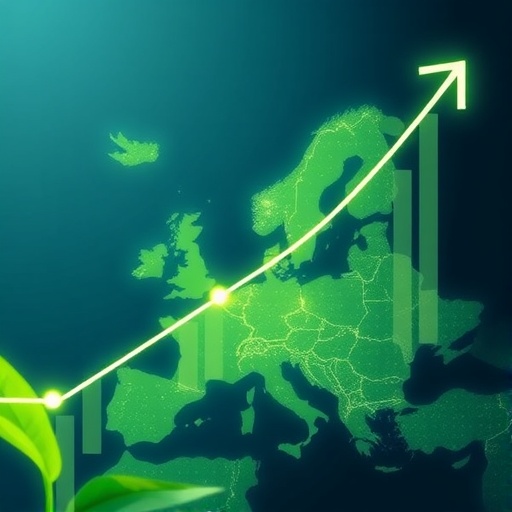In an era defined by environmental challenges and technological advancements, the intersection of green innovation and digitalization is garnering significant attention. A recent study published in Discover Sustainability examines the nuanced roles these factors play in influencing economic growth within the European Union. By taking a comprehensive look at both symmetric and asymmetric impacts, researchers have shed light on how strategic investments in green technologies and digital infrastructure can propel sustainable growth.
The research highlights the urgency for stakeholders in the EU to leverage these innovations to meet both economic and environmental objectives. The findings indicate that while green innovation yields considerable benefits, the integration of digital tools can amplify these effects, leading to enhanced productivity and a more sustainable economic model. The groundwork laid by the study underscores the potential for well-coordinated policies that effectively harmonize these forces, suggesting that the EU could emerge as a global leader in sustainable economic practices.
The authors, Gharbi, Zarrad, and Kalai, delve deeply into the implications of their findings. Central to their argument is the concept of green innovation, which encompasses a range of initiatives aimed at reducing environmental impacts while fostering economic activity. They argue that investment in renewable energy technologies, waste management systems, and sustainable agriculture practices can collectively lead to improved economic indicators. Furthermore, these green initiatives do not merely represent costs; rather, they can generate substantial returns on investment when effectively implemented.
Moreover, the study explores the role of digitalization as a catalyst for green innovation. By employing advanced data analytics and IoT (Internet of Things) technologies, companies can optimize their resource consumption, thus furthering ecological goals. For instance, smart grids enable more efficient energy distribution, and digital monitoring tools provide real-time insights into environmental impacts, enhancing decision-making processes. The juxtaposition of these two areas presents a compelling argument for comprehensive strategies that integrate both green and digital initiatives.
A major aspect of the research is its acknowledgment of the possible asymmetries in the impacts of these innovations. Not all sectors within the EU may benefit equally from green technologies and digitalization. Certain industries, particularly those with historically high emissions, may experience more pronounced improvements in productivity and environmental compliance compared to others. The authors emphasize the need for tailored approaches to policy-making, where solutions can be adapted based on sector-specific challenges and capacities.
As the EU seeks to position itself as a frontrunner in the global green economy, the study offers critical insights into how these innovations can shape future growth trajectories. Policymakers are encouraged to foster environments conducive to experimentation and investment in green technologies. The research suggests that such environments not only spur innovation but also create new jobs, enhancing overall economic resilience.
Furthermore, the socio-economic implications of these findings cannot be ignored. The integration of sustainable practices and digital tools can address issues of inequality and employment, especially in regions heavily reliant on traditional industries. By facilitating a transition to greener jobs, the EU stands to benefit from improved social cohesion and community engagement. These aspects further strengthen the argument for coordinated policy interventions that prioritize green innovation and digitalization.
Reflecting on the financial aspects, the research indicates that the adoption of green technologies often comes with upfront costs. However, the long-term savings achieved through increased operational efficiencies and reduced regulatory fines can offset these initial investments. The authors advocate for financial incentives, public-private partnerships, and grants that lower barriers to entry for companies hesitant to embrace this transition.
Additionally, the researched interoperability between various stakeholders is paramount. Collaboration among governments, businesses, research institutions, and civil societies can accelerate the deployment of sustainable technologies. The study emphasizes the importance of creating networks that facilitate the exchange of knowledge and best practices, ultimately driving a collective push toward economic sustainability.
In conclusion, the investigation presents a compelling case for the dual focus on green innovation and digitalization as integral components of the EU’s growth strategy. The transformative potential of these innovations could significantly alter the landscape of economic growth, paving the way for a sustainable and equitable future. However, to realize this potential, stakeholders must commit to a shared vision that champions coordinated action across all sectors. As we reflect on the implications of this study, the urgency for such a transformation has never been clearer, and the opportunity for leadership in sustainable economic practices lies predominantly within the hands of the European Union.
As the world continues to grapple with the aftermath of industrialization and its repercussions on climate change, the insights gleaned from this research become increasingly vital. By recognizing and harnessing the productive interplay between green innovation and digitalization, the European Union can not only enhance its economic performance but also set a benchmark for other regions worldwide. The onus is now on those in power to deliver on this promise of sustainability, guided by the informed recommendations from this pioneering research.
Subject of Research: The impact of green innovation and digitalization on economic growth in the European Union.
Article Title: Examining the symmetric and the asymmetric impacts of green innovation and digitalization on the European Union’s green economic growth.
Article References:
Gharbi, S., Zarrad, O., Kalai, M. et al. Examining the symmetric and the asymmetric impacts of green innovation and digitalization on the European Union’s green economic growth. Discov Sustain 6, 929 (2025). https://doi.org/10.1007/s43621-025-01531-z
Image Credits: AI Generated
DOI: 10.1007/s43621-025-01531-z
Keywords: Green Innovation, Digitalization, Economic Growth, Sustainability, European Union.




